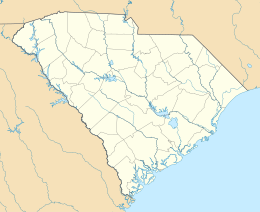Morgan Island, South Carolina
Nickname: Monkey Island | |
|---|---|
| Geography | |
| Location | Atlantic Ocean |
| Coordinates | 32°27′55″N 80°31′10″W / 32.4652°N 80.5194°W |
| Archipelago | Sea Islands |
| Area | 1,816.63 ha (4,489.0 acres) |
| Administration | |
United States | |
| State | South Carolina |
| County | Beaufort |
| Demographics | |
| Population | 0 (about 4000 rhesus monkeys) |
Morgan Island is one of the Sea Islands, located in Beaufort County, South Carolina, just north of Beaufort. It is also known as Monkey Island due to its colony of free-ranging rhesus monkeys, established in 1979.[1][2][3][4][5]
Geography[edit]
Morgan Island is a 4,489-acre (1,817-hectare) marshland island that consists of 635 acres (257 ha) of upland. The island is located between the Morgan and Coosaw rivers and borders the Saint Helena Sound to the south and Parrot Creek to the north. The marshland area includes three major tidal creeks as well as other small creeks.[1] Morgan Island is uninhabited, and is home to a breeding colony of approximately 3,500 free-ranging, Indian-origin rhesus monkeys. There is a 370-acre (150 ha) portion of upland that supports a semi-tropical maritime forest where the monkey colony primarily resides.[1]
The colony on Morgan Island is one of only two rhesus monkey colonies in the continental United States, the other being on the Silver River in Florida.[6]
Monkey colony[edit]
Historically, the island has been uninhabited due to its location and distance from the mainland. Originally, the monkey colony now located on Morgan Island was located at the Caribbean Primate Research Center in La Parguera, Puerto Rico.[5] According to the Centers for Disease Control and Prevention (CDC), there were incidents of the free-ranging monkeys escaping, carrying viral herpes B infections, which lead to outbreaks in the local population. Puerto Rico was alarmed by this, and South Carolina stepped in to offer an uninhabited island for research. In 1979 and 1980, over 1,400 animals were relocated to Morgan Island.[5]
The island is owned by the South Carolina Department of Natural Resources (SCDNR). The monkeys that live on the island are owned by the National Institute of Allergy and Infectious Diseases (NIAID), and used for public health research.[7]
Conservation[edit]
Morgan Island lies within the ACE Basin National Estuarine Research Reserve, under the National Estuarine Research Reserve system (NERR).[1][8]
References[edit]
- ^ a b c d Klopchin, Jeanette L.; Stewart, Jill R.; Webster, Laura F.; Sandifer, Paul A. (2008-02-01). "Assessment of environmental impacts of a colony of free-ranging rhesus monkeys (Macca mulatta) on Morgan Island, South Carolina" (PDF). Environmental Monitoring and Assessment. 137 (1): 301–313. doi:10.1007/s10661-007-9766-3. ISSN 1573-2959. PMID 17564800. S2CID 19169441. Archived from the original on 2014-03-12.
- ^ Lewis Turner "Monkey Island, South Carolina: Fact or Fiction", WLTX, May 21, 2010.
- ^ Holly Bounds, "Morgan Island: Beaufort County's Island of Monkeys" , WSAV-TV, April 30, 2012.
- ^ Bo Peterson, "Morgan Island gains higher public profile", The Post and Courier, December 19, 2005. via HighBeam Research.
- ^ a b c Taub, D. M.; Mehlman, P. T. (1989-04-01). "Development of the Morgan Island rhesus monkey colony". Puerto Rico Health Sciences Journal. 8 (1): 159–169. ISSN 0738-0658. PMID 2780958.
- ^ Anderson, C. Jane; Van De Kerk, Madelon; Pine, William E.; Hostetler, Mark E.; Heard, Darryl J.; Johnson, Steve A. (2018-10-26). "Population estimate and management options for introduced rhesus macaques". The Journal of Wildlife Management. 83 (2): 295–303. doi:10.1002/jwmg.21588. ISSN 0022-541X. S2CID 92091634.
- ^ Weismann, Lisa (2021-12-17). "Congresswoman Draws Attention to Testing on S.C. Island Monkeys". WRDW-TV News 12. Archived from the original on 2022-07-28. Retrieved 2022-12-30.
- ^ Owen, Beth; White, Susan, eds. (2005). National Estuarine Research Reserve System 10 Anniversary Report on the System-wide Monitoring Program (SWMP) Data Applications: 1995–2005 (PDF). Archived from the original (PDF) on 2017-01-31.

